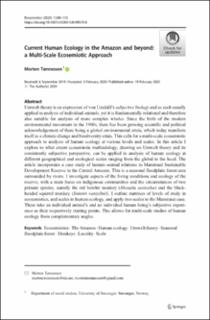| dc.contributor.author | Tønnessen, Morten | |
| dc.coverage.spatial | The Amazon | en_US |
| dc.date.accessioned | 2020-11-23T09:47:18Z | |
| dc.date.available | 2020-11-23T09:47:18Z | |
| dc.date.created | 2020-06-05T14:52:23Z | |
| dc.date.issued | 2020 | |
| dc.identifier.citation | Tønnessen, M. (2020) Current human ecology in the Amazon and beyond: A multi-scale ecosemiotic approach. Biosemiotics, 13 (1), pp. 89-113. | en_US |
| dc.identifier.issn | 1875-1342 | |
| dc.identifier.uri | https://hdl.handle.net/11250/2689006 | |
| dc.description.abstract | Umwelt theory is an expression of von Uexküll’s subjective biology and as such usually applied in analysis of individual animals, yet it is fundamentally relational and therefore also suitable for analysis of more complex wholes. Since the birth of the modern environmental movement in the 1960s, there has been growing scientific and political acknowledgement of there being a global environmental crisis, which today manifests itself as a climate change and biodiversity crisis. This calls for a multi-scale ecosemiotic approach to analysis of human ecology at various levels and scales. In this article I explore to what extent ecosemiotic methodology, drawing on Umwelt theory and its consistently subjective perspective, can be applied in analysis of human ecology at different geographical and ecological scales ranging from the global to the local. The article incorporates a case study of human–animal relations in Mamirauá Sustainable Development Reserve in the Central Amazon. This is a seasonal floodplain forest area surrounded by rivers. I investigate aspects of the living conditions and ecology of the reserve, with a main focus on indigenous communities and the circumstances of two primate species, namely the red howler monkey (Alouatta seniculus) and the blackheaded squirrel monkey (Saimiri vanzolinii). I outline matrixes of levels of study in ecosemiotics, and scales in human ecology, and apply two scales to the Mamirauá case. These take an individual animal’s and an individual human being’s subjective experience as their respectively starting points. This allows for multi-scale studies of human ecology from complementary angles. | en_US |
| dc.language.iso | eng | en_US |
| dc.publisher | Springer | en_US |
| dc.relation.uri | https://link.springer.com/article/10.1007/s12304-020-09379-8#Ack1 | |
| dc.rights | Navngivelse 4.0 Internasjonal | * |
| dc.rights.uri | http://creativecommons.org/licenses/by/4.0/deed.no | * |
| dc.subject | umnwelt | en_US |
| dc.subject | økosemiotikk | en_US |
| dc.subject | økologi | en_US |
| dc.subject | aper | en_US |
| dc.subject | Amazonas | en_US |
| dc.title | Current human ecology in the Amazon and beyond: A multi-scale ecosemiotic approach | en_US |
| dc.type | Peer reviewed | en_US |
| dc.type | Journal article | en_US |
| dc.description.version | publishedVersion | en_US |
| dc.rights.holder | (C) The Author | en_US |
| dc.subject.nsi | VDP::Humaniora: 000 | en_US |
| dc.source.pagenumber | 89-113 | en_US |
| dc.source.volume | 13 | en_US |
| dc.source.journal | Biosemiotics | en_US |
| dc.source.issue | 1 | en_US |
| dc.identifier.doi | 10.1007/s12304-020-09379-8 | |
| dc.identifier.cristin | 1814072 | |
| dc.relation.project | Universitetet i Stavanger: IN-11621 | en_US |
| cristin.ispublished | true | |
| cristin.fulltext | original | |
| cristin.qualitycode | 1 | |

